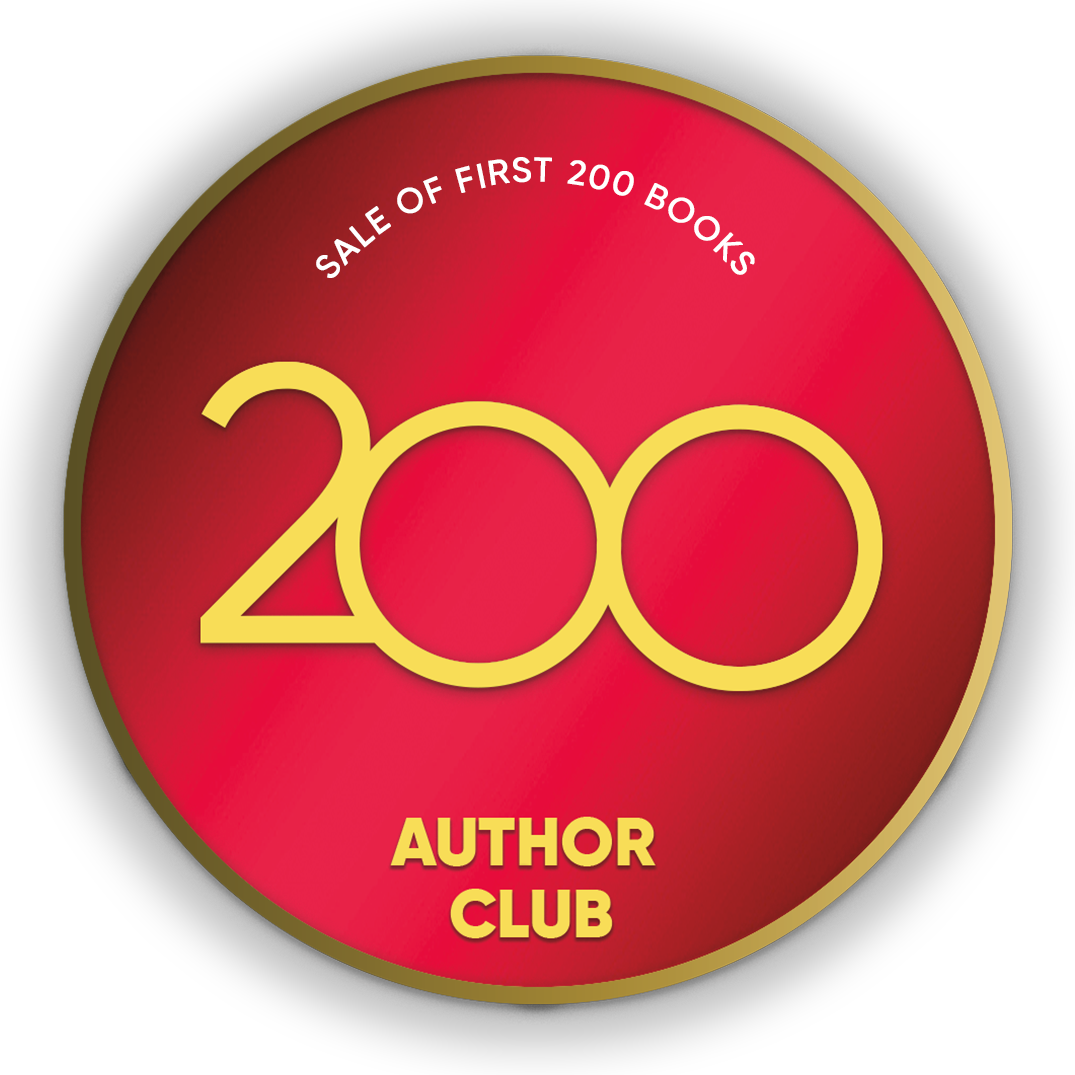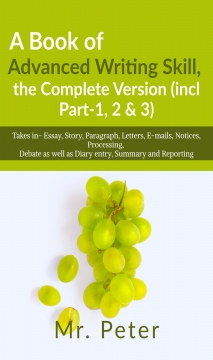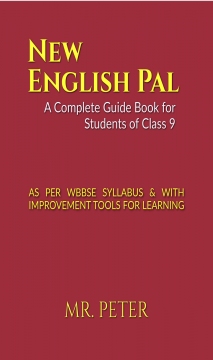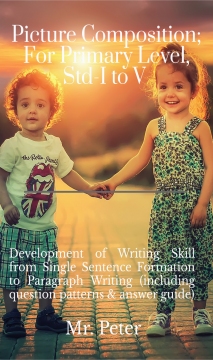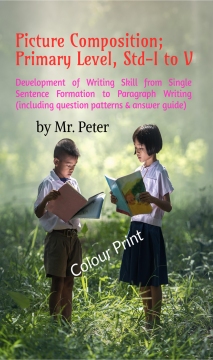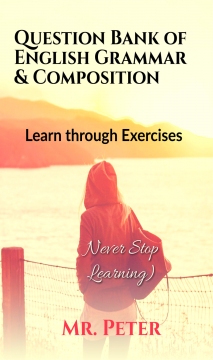
- Discover books
- For Writers
-
For Writers
-
Indie Author Championship
-
Challenges
Writing Contests
- Get Started

"It was a wonderful experience interacting with you and appreciate the way you have planned and executed the whole publication process within the agreed timelines.”
Subrat SaurabhAuthor of Kuch Woh Pal -
-
-
IN
- India
- Singapore
- Malaysia
- 0
Crop your profile image

English Grammar & Composition at the Primary Level, including Unseen Passages
Books by P. Sarkar
In the current project focused on grammar books for various classes, Mr. Sarkar has made a concerted effort to simplify English grammar and writing skills for primary-level students. He conducted extensive research on the syllabi of different state and national school boards to identify a common thread. While some boards emphasize specific chapters of English grammar, others overlook them entirely. Mr. Sarkar has aimed to synthesize these varying approaches an
In the current project focused on grammar books for various classes, Mr. Sarkar has made a concerted effort to simplify English grammar and writing skills for primary-level students. He conducted extensive research on the syllabi of different state and national school boards to identify a common thread. While some boards emphasize specific chapters of English grammar, others overlook them entirely. Mr. Sarkar has aimed to synthesize these varying approaches and present them as a cohesive summary of English grammar and composition.
As a result, his book may not fully align with any single syllabus from boards in the country or abroad. Still, he believes it will give students a holistic understanding of English grammar and Composition, enabling them to grasp the subject more effectively and write composition more fluently.
Regarding composition, Mr. Sarkar has primarily relied on everyday language and selected familiar topics to engage his loving young readers.
Thanking you
Author(s)
English Grammar & Composition at the Primary Level, including Unseen Passages
Books by P. Sarkar
In the current project focused on grammar books for various classes, Mr. Sarkar has made a concerted effort to simplify English grammar and writing skills for primary-level students. He conducted extensive research on the syllabi of different state and national school boards to identify a common thread. While some boards emphasize specific chapters of English grammar, others overlook them entirely. Mr. Sarkar has aimed to synthesize these varying approaches an
In the current project focused on grammar books for various classes, Mr. Sarkar has made a concerted effort to simplify English grammar and writing skills for primary-level students. He conducted extensive research on the syllabi of different state and national school boards to identify a common thread. While some boards emphasize specific chapters of English grammar, others overlook them entirely. Mr. Sarkar has aimed to synthesize these varying approaches and present them as a cohesive summary of English grammar and composition.
As a result, his book may not fully align with any single syllabus from boards in the country or abroad. Still, he believes it will give students a holistic understanding of English grammar and Composition, enabling them to grasp the subject more effectively and write composition more fluently.
Regarding composition, Mr. Sarkar has primarily relied on everyday language and selected familiar topics to engage his loving young readers.
Thanking you
Author(s)
New English Pal, Class 10
Books by P. Sarkar
‘New English Pal (A Complete Guide Book for Smart Learning)’ is a series of books for classes 5 to 10, based on the WBBSE and WBBME syllabi; one book for each class that includes Textual Questions with Tips for answers, Grammar Questions for Practice and Writing Skills with model answers. The book covers MCQ, VSAQ, SAQ, and ETQs for Summative Evaluation, Formative, and Project Works.
From Text to Grammar and Writing Skills, all are en
‘New English Pal (A Complete Guide Book for Smart Learning)’ is a series of books for classes 5 to 10, based on the WBBSE and WBBME syllabi; one book for each class that includes Textual Questions with Tips for answers, Grammar Questions for Practice and Writing Skills with model answers. The book covers MCQ, VSAQ, SAQ, and ETQs for Summative Evaluation, Formative, and Project Works.
From Text to Grammar and Writing Skills, all are entirely based on the West Bengal Board of Secondary Education and the West Bengal Board of Madrasah Education.
Thanking with,
Author(s).
New English Pal, Class 9
Books by P. Sarkar
‘New English Pal (A Complete Guide Book for Smart Learning)’ is a series of books for classes 5 to 10, based on the WBBSE and WBBME syllabi; one book for each class that includes Textual Questions with Tips for answers, Grammar Questions for Practice and Writing Skills with model answers. The book covers MCQ, VSAQ, SAQ, and ETQs for Summative Evaluation, Formative, and Project Works.
From Text to Grammar and Writing Skills, all are en
‘New English Pal (A Complete Guide Book for Smart Learning)’ is a series of books for classes 5 to 10, based on the WBBSE and WBBME syllabi; one book for each class that includes Textual Questions with Tips for answers, Grammar Questions for Practice and Writing Skills with model answers. The book covers MCQ, VSAQ, SAQ, and ETQs for Summative Evaluation, Formative, and Project Works.
From Text to Grammar and Writing Skills, all are entirely based on the West Bengal Board of Secondary Education and the West Bengal Board of Madrasah Education.
Thanking with,
Author(s).
New English Pal, Class 8
Books by P. Sarkar, Bipradip Sarkar
‘New English Pal (A Complete Guide Book for Smart Learning)’ is a series of books for classes 5 to 10, based on the WBBSE and WBBME syllabi; one book for each class that includes Textual Questions with Tips for answers, Grammar Questions for Practice and Writing Skills with model answers. The book covers MCQ, VSAQ, SAQ, and ETQs for Summative Evaluation, Formative, and Project Works.
From Text to Grammar and Writing Skills, all are en
‘New English Pal (A Complete Guide Book for Smart Learning)’ is a series of books for classes 5 to 10, based on the WBBSE and WBBME syllabi; one book for each class that includes Textual Questions with Tips for answers, Grammar Questions for Practice and Writing Skills with model answers. The book covers MCQ, VSAQ, SAQ, and ETQs for Summative Evaluation, Formative, and Project Works.
From Text to Grammar and Writing Skills, all are entirely based on the West Bengal Board of Secondary Education and the West Bengal Board of Madrasah Education.
Thanking with,
Author(s).
New English Pal, Class 5
Books by P. Sarkar
‘New English Pal (A Complete Guide Book for Smart Learning)’ is a series of books for classes 5 to 10, based on the WBBSE and WBBME syllabi; one book for each class that includes Textual Questions with Tips for answers, Grammar Questions for Practice and Writing Skills with model answers. The book covers MCQ, VSAQ, SAQ, and ETQs for Summative Evaluation, Formative, and Project Works.
From Text to Grammar and Writing Skills, all are en
‘New English Pal (A Complete Guide Book for Smart Learning)’ is a series of books for classes 5 to 10, based on the WBBSE and WBBME syllabi; one book for each class that includes Textual Questions with Tips for answers, Grammar Questions for Practice and Writing Skills with model answers. The book covers MCQ, VSAQ, SAQ, and ETQs for Summative Evaluation, Formative, and Project Works.
From Text to Grammar and Writing Skills, all are entirely based on the West Bengal Board of Secondary Education and the West Bengal Board of Madrasah Education.
Thanking with,
Author(s).
A Book of Advanced Writing Skill, the Complete Version (incl Part-1, 2 & 3)
Books by Mr. Peter
Mr. Peter’s ‘Advanced Writing Skill, the Complete Version’ consists of three Parts (Part 1, Part 2 & Part 3). Part 1, “Steps to Composition includes all types of paragraph writing, essay writing, picture story composition, and story writing with titles and morals where applicable. Part 2, “Development of Writing Skill” includes all kinds of Letter Writing: business letters, applications for jobs—letters to editors&mdas
Mr. Peter’s ‘Advanced Writing Skill, the Complete Version’ consists of three Parts (Part 1, Part 2 & Part 3). Part 1, “Steps to Composition includes all types of paragraph writing, essay writing, picture story composition, and story writing with titles and morals where applicable. Part 2, “Development of Writing Skill” includes all kinds of Letter Writing: business letters, applications for jobs—letters to editors—letters to Institutional Heads, municipalities, and banks—and Informal letters to friends, relatives, acquaintances, and parents. The 3rd book in the series of Writing Skills, i.e., “Development of Writing Skill, Part 3” includes all other important sections of writing skills and composition, which are necessary for practice by students and learners. The book includes- E-mails, Poster Making, Notices, Processing, Dialogue, Articles, Speech and debate Writing as well as Diary entry, Summary, Reporting, etc.
Development of Writing Skill, Part-2
Books by Mr. Peter
In writing skills and composition, Mr. Peter has tried to include all necessary writing skills and methods suitable for students of all standards, from primary to higher secondary level. Thus, his entire attempt led to the formation of Peter’s ‘Advanced Writing Skill, the Complete Version,’ which consists of three Parts (Part 1, Part 2, and Part 3).
Part 1, “Steps to Composition includes all types of paragraph writing, ess
In writing skills and composition, Mr. Peter has tried to include all necessary writing skills and methods suitable for students of all standards, from primary to higher secondary level. Thus, his entire attempt led to the formation of Peter’s ‘Advanced Writing Skill, the Complete Version,’ which consists of three Parts (Part 1, Part 2, and Part 3).
Part 1, “Steps to Composition includes all types of paragraph writing, essay writing, picture story composition, and story writing with titles and morals where applicable.
Part 2, “Development of Writing Skill,” includes mainly Letter Writing—business letters, job applications, letters to editors, letters to Institutional Heads, municipalities, and banks, and Informal letters to friends, relatives, acquaintances, and parents.
The third book in the Writing Skills series, “Development of Writing Skill, Part-3,” includes all other essential writing skills sections that students must practice. Thus, the book consists of E-mails, Poster Making, Notices, Processing, Dialogue, Articles, Speech and debate Writing, diary entries, Summary, and Reporting for school newsletters and Newspapers with ample examples for study and exercises.
The Rainbow
Books by P. Sarkar
The title of the book ‘The Rainbow’ is named after a story in it. The stories in the book cover a wide array of themes, ranging from realistic to fictional, all of which are highly enjoyable and engaging. Some stories are intensely realistic, touching on family dynamics and struggles and delving into individuals' psychological crises.
The title of the book ‘The Rainbow’ is named after a story in it. The stories in the book cover a wide array of themes, ranging from realistic to fictional, all of which are highly enjoyable and engaging. Some stories are intensely realistic, touching on family dynamics and struggles and delving into individuals' psychological crises.
Steps to Composition (Development of Writing Skill, from Primary to Secondary Level)
Books by Mr. Peter
Mr. Peter’s “Steps to Composition (Development of Writing Skill, from Primary to Secondary Level” is the first part of a book called ‘Advanced Writing Skill, the Complete Version,’ which contains three parts (Part-1, Part-2 & Part-3).
Part 1 of the book includes all types of paragraph writing, essay writing, picture story composition, and story writing for students from Primary to Higher Secondary levels. It separately c
Mr. Peter’s “Steps to Composition (Development of Writing Skill, from Primary to Secondary Level” is the first part of a book called ‘Advanced Writing Skill, the Complete Version,’ which contains three parts (Part-1, Part-2 & Part-3).
Part 1 of the book includes all types of paragraph writing, essay writing, picture story composition, and story writing for students from Primary to Higher Secondary levels. It separately covers paragraphs from autobiographical to biographical, narrative writing to descriptive writing, and Picture Story Composition. On the other hand, Part 2, “Development of Writing Skill,” includes mainly Letter Writing, both Formal and informal, and they are further sub-divided as—business letters, applications for jobs—letters to editors—letters to Institutional Heads, and the Informal letters to friends, relatives, acquaintances, and parents.
Part 3, “Development of Writing Skill,” includes all remaining methods of writing skills for school students, such as E-mails, Notices, Processing, Dialogue, Article, Speech, and debate Writing, as well as Diary entry, Summary, and Reporting for the school newsletter and Newspaper.
Rhetoric & Prosody
Books by Mr. Peter
The book 'Rhetoric & Prosody, a handbook of Figures of Speech, rhymes, and poetic feet for High School Students is specifically crafted for high school students. It covers chapters on Rhetoric, the seven classes of Figures of Speech, which are often referred to as the embellishments of speech, used by writers or leaders to impress their readers or audience. The book delves into similes, metaphors, antitheses, epigrams, oxymoron, metonymy, synecdoche, hypallage
The book 'Rhetoric & Prosody, a handbook of Figures of Speech, rhymes, and poetic feet for High School Students is specifically crafted for high school students. It covers chapters on Rhetoric, the seven classes of Figures of Speech, which are often referred to as the embellishments of speech, used by writers or leaders to impress their readers or audience. The book delves into similes, metaphors, antitheses, epigrams, oxymoron, metonymy, synecdoche, hypallage, personification, pathetic fallacy, apostrophe, vision, hyperbole, irony, euphemism, alliteration, pun, and more, providing brief illustrations and examples for each.
In the Prosody section, the book discusses rhyme, meter, poetic feet, and the art of scansion to help readers understand poetic lines. It also introduces various verse forms and literary terms with definitions and examples tailored for high school students. The book includes an illustrated table of contents to inform readers of its contents and facilitate easy navigation to specific topics related to figures of speech and prosody, ultimately saving valuable time for readers. In conclusion, the author expresses gratitude and thanks to those who found the book helpful and humbly asks for forgiveness for any inconvenience caused to those who did not. Thank you,
Author
Study of Subject-Verb Agreement, Narration Change, Use of Punctuation; including Analysis, Synthesis & Split-up
Books by Mr. Peter
The book encompasses chapters on subject-verb agreement and the analysis of simple, compound, and complex sentences. It first examines these as subjects and predicates, followed by an in-depth exploration of subject adjuncts and adverbial adjuncts in simple sentences, with additional discussions on compound and complex structures. Key topics such as synthesis, joining, and separation are illustrated comprehensively. Furthermore, the text covers various narrati
The book encompasses chapters on subject-verb agreement and the analysis of simple, compound, and complex sentences. It first examines these as subjects and predicates, followed by an in-depth exploration of subject adjuncts and adverbial adjuncts in simple sentences, with additional discussions on compound and complex structures. Key topics such as synthesis, joining, and separation are illustrated comprehensively. Furthermore, the text covers various narration changes and sentence conversions—approximately thirty-two types—providing invaluable insights. Additionally, sixteen punctuation marks, including the use of capital letters, parentheses, and asterisks, are discussed in detail, accompanied by examples.
Detail Study of Phrases, Clauses & Sentences, including Idioms & Phrasal Verbs
Books by Mr. Peter
The book discusses phrases, clauses, sentences, moods, and verb expressions in detail. It also discusses sentence classification based on moods and clauses. The book includes definitions and various comparison charts that display similarities and differences among topics, along with necessary examples to support the discussion.
The book covers the seven types of phrases, their nature and functions, and the functions of corresponding words (parts of spe
The book discusses phrases, clauses, sentences, moods, and verb expressions in detail. It also discusses sentence classification based on moods and clauses. The book includes definitions and various comparison charts that display similarities and differences among topics, along with necessary examples to support the discussion.
The book covers the seven types of phrases, their nature and functions, and the functions of corresponding words (parts of speech). It demonstrates how clauses form simple, compound, and complex sentences and how verb moods and manner of expression determine sentence classification based on function. Besides, the book includes different conditionals, wish clauses, a list of phrasal verbs, and 372 idioms.
Study of Adverbs, Prepositions, Conjunctions & Interjections
Books by Mr. Peter
The book covers a comprehensive study of the four parts of speech: Adverbs, Prepositions, Conjunctions, and Interjections. While the other four elements have their dedicated books, this one thoroughly examines these components: Adverbs, Prepositions, Conjunctions, and Interjections. It includes detailed definitions, classifications, forms, and formations and ample examples for each section. The content is suitable for high school students and is designed to fa
The book covers a comprehensive study of the four parts of speech: Adverbs, Prepositions, Conjunctions, and Interjections. While the other four elements have their dedicated books, this one thoroughly examines these components: Adverbs, Prepositions, Conjunctions, and Interjections. It includes detailed definitions, classifications, forms, and formations and ample examples for each section. The content is suitable for high school students and is designed to facilitate easy comprehension. In addition to addressing Adverbs, the book also includes discussions on Degrees, Forms & Formation, and the Position of Adverbs in sentences. It delves into the Adverbial Function of Prepositions, highlights the Role of Conjunctions, and provides numerous examples of how different Interjections express various emotions and the speaker's feelings.
Peter's ‘English Grammar’
Books by Mr. Peter
Peter's English Grammar is a comprehensive guide designed for high school students. It covers all aspects of English grammar from A to Z in a systematic manner, progressing from basic to advanced topics. The book is structured into five main parts, each of which is also available as a standalone book in the digital market. The first part covers Nouns, Pronouns, and Adjectives. The second part exclusively covers verbs in fifteen chapters. The third part contain
Peter's English Grammar is a comprehensive guide designed for high school students. It covers all aspects of English grammar from A to Z in a systematic manner, progressing from basic to advanced topics. The book is structured into five main parts, each of which is also available as a standalone book in the digital market. The first part covers Nouns, Pronouns, and Adjectives. The second part exclusively covers verbs in fifteen chapters. The third part contains Adverbs, Prepositions, Conjunctions, & Interjections. The fourth part delves into Phrases, Clauses, and Sentence structure, including a list of Idioms & Phrasal Verbs. The final section analyzes and breaks down sentences and illustrates synthesis, subject-verb agreement, and miscellaneous. Mr. Peter also acknowledges the book's shortcomings and encourages readers to explore his other books to enhance their writing skills.
Thanking you,
Mr. Peter.
All about Verbs (Forms, Functions, Conjugation, Tense, Voice Change, Forming Questions & Negation)
Books by Mr. Peter
The comprehensive guide 'All about Verbs' explores verbs in-depth, featuring fifteen main chapters, over fifty topics, and various exercises. It analyses key categories of verbs using a unique approach to verb trees. It covers verb classification, types of verbs, and their functions. The guide also includes chapters on verb conjugation, tense, voice change, forming Questions, and Negative sentences using verbs and negation words.
The comprehensive guide 'All about Verbs' explores verbs in-depth, featuring fifteen main chapters, over fifty topics, and various exercises. It analyses key categories of verbs using a unique approach to verb trees. It covers verb classification, types of verbs, and their functions. The guide also includes chapters on verb conjugation, tense, voice change, forming Questions, and Negative sentences using verbs and negation words.
Study of Nouns, Pronouns, Adjectives & Articles (detail study)
Books by Mr. Peter
The book begins by introducing letters, words, and syllables. It gradually moves from Parts of Speech to a detailed study of Nouns, Pronouns, Adjectives, and Articles.
The book shows how The Case of Nouns defines the different functions of Nouns. Without studying the functions of Nouns, we can’t identify the class of Nouns and their roles in sentences. The book discusses the functions of nouns in detail and shows how nouns form subjects, ob
The book begins by introducing letters, words, and syllables. It gradually moves from Parts of Speech to a detailed study of Nouns, Pronouns, Adjectives, and Articles.
The book shows how The Case of Nouns defines the different functions of Nouns. Without studying the functions of Nouns, we can’t identify the class of Nouns and their roles in sentences. The book discusses the functions of nouns in detail and shows how nouns form subjects, objects, and phrases in apposition and complements. Besides, it discusses how nouns sometimes act or work like adjectives, form nominal Compound and prepositional objects, and are also a part of an adverbial phrase.
The book illustrates each topic related to Nouns, including number, gender, case, the functions of nouns, the role and classification of Pronouns, and the functions of Adjectives in detail, including articles and determiners.
Thus, the book includes and illustrates the three crucial pillars of Parts of Speech—nouns, Pronouns, and adjectives. Peter hopes the book will help the learners understand nouns, Pronouns, and adjectives and prepare them for the next part of the complete version.
The Rainbow
Books by P. Sarkar
The title of the book ‘The Rainbow’ is named after a story in it. The stories in the book cover a wide array of themes, ranging from realistic to fictional, all of which are highly enjoyable and engaging. Some stories are intensely realistic, touching on family dynamics and struggles and delving into individuals' psychological crises.
The title of the book ‘The Rainbow’ is named after a story in it. The stories in the book cover a wide array of themes, ranging from realistic to fictional, all of which are highly enjoyable and engaging. Some stories are intensely realistic, touching on family dynamics and struggles and delving into individuals' psychological crises.
New English Pal, Class 9
Books by P. Sarkar
‘New English Pal (A Complete Guide Book for Smart Learning)’ is a series of books for classes 5 to 10, based on the WBBSE and WBBME syllabi; one book for each class that includes Textual Questions with Tips for answers, Grammar Questions for Practice and Writing Skills with model answers. The book covers MCQ, VSAQ, SAQ, and ETQs for Summative Evaluation, Formative, and Project Works.
From Text to Grammar and Writing Skills, all are en
‘New English Pal (A Complete Guide Book for Smart Learning)’ is a series of books for classes 5 to 10, based on the WBBSE and WBBME syllabi; one book for each class that includes Textual Questions with Tips for answers, Grammar Questions for Practice and Writing Skills with model answers. The book covers MCQ, VSAQ, SAQ, and ETQs for Summative Evaluation, Formative, and Project Works.
From Text to Grammar and Writing Skills, all are entirely based on the West Bengal Board of Secondary Education and the West Bengal Board of Madrasah Education.
Thanking with,
Author(s).
New English Pal, Class 10
Books by P. Sarkar
‘New English Pal (A Complete Guide Book for Smart Learning)’ is a series of books for classes 5 to 10, based on the WBBSE and WBBME syllabi; one book for each class that includes Textual Questions with Tips for answers, Grammar Questions for Practice and Writing Skills with model answers. The book covers MCQ, VSAQ, SAQ, and ETQs for Summative Evaluation, Formative, and Project Works.
From Text to Grammar and Writing Skills, all are en
‘New English Pal (A Complete Guide Book for Smart Learning)’ is a series of books for classes 5 to 10, based on the WBBSE and WBBME syllabi; one book for each class that includes Textual Questions with Tips for answers, Grammar Questions for Practice and Writing Skills with model answers. The book covers MCQ, VSAQ, SAQ, and ETQs for Summative Evaluation, Formative, and Project Works.
From Text to Grammar and Writing Skills, all are entirely based on the West Bengal Board of Secondary Education and the West Bengal Board of Madrasah Education.
Thanking with,
Author(s).
New English Pal
Books by Mr. Peter
Peter’s ‘New English Pal’ is designed for students from class 5 to 12, a separate book for each class as per the WBBSE syllabus, which includes extended questions on each chapter of poem and prose, to prepare his students for all type of questions MCQ, VSAQ, SAQ, LAQ for Summative Evaluation along with the Project Works, Sample Charts and Questions for Formative Evaluation.
Grammar Section is set as per syllabus of each class and th
Peter’s ‘New English Pal’ is designed for students from class 5 to 12, a separate book for each class as per the WBBSE syllabus, which includes extended questions on each chapter of poem and prose, to prepare his students for all type of questions MCQ, VSAQ, SAQ, LAQ for Summative Evaluation along with the Project Works, Sample Charts and Questions for Formative Evaluation.
Grammar Section is set as per syllabus of each class and the topics in the Writing Skill for their guides to practice. The sentences, illustrations and examples are given and written in simple language and in the order of grammar given in their text books. However, some extra topics of grammar have also been included so that a student does not face difficulty to grasp a new point.
Thanking with,
Authors.
Development of Writing Skill, Part-2
Books by Mr. Peter
In writing skills and composition, Mr. Peter has tried to include all necessary writing skills and methods suitable for students of all standards, from primary to higher secondary level. Thus, his entire attempt led to the formation of Peter’s ‘Advanced Writing Skill, the Complete Version,’ which consists of three Parts (Part 1, Part 2, and Part 3).
Part 1, “Steps to Composition includes all types of paragraph writing, ess
In writing skills and composition, Mr. Peter has tried to include all necessary writing skills and methods suitable for students of all standards, from primary to higher secondary level. Thus, his entire attempt led to the formation of Peter’s ‘Advanced Writing Skill, the Complete Version,’ which consists of three Parts (Part 1, Part 2, and Part 3).
Part 1, “Steps to Composition includes all types of paragraph writing, essay writing, picture story composition, and story writing with titles and morals where applicable.
Part 2, “Development of Writing Skill,” includes mainly Letter Writing—business letters, job applications, letters to editors, letters to Institutional Heads, municipalities, and banks, and Informal letters to friends, relatives, acquaintances, and parents.
The third book in the Writing Skills series, “Development of Writing Skill, Part-3,” includes all other essential writing skills sections that students must practice. Thus, the book consists of E-mails, Poster Making, Notices, Processing, Dialogue, Articles, Speech and debate Writing, diary entries, Summary, and Reporting for school newsletters and Newspapers with ample examples for study and exercises.
Picture Composition; For Primary Level, Std-I to V
Books by Mr. Peter
In the book ‘Picture Composition; Primary Level, Std-I to V’ the arrangement is made to take a student from a base level of forming a single sentence to writing a full paragraph. The students will learn all these in different steps, beginning with single sentence formation to two; then three, four, and building up short paragraphs observing pictures.
In the book ‘Picture Composition; Primary Level, Std-I to V’ the arrangement is made to take a student from a base level of forming a single sentence to writing a full paragraph. The students will learn all these in different steps, beginning with single sentence formation to two; then three, four, and building up short paragraphs observing pictures.
Steps to Composition (Development of Writing Skill, from Primary to Secondary Level)
Books by Mr. Peter
Mr. Peter’s “Steps to Composition (Development of Writing Skill, from Primary to Secondary Level” is the first part of a book called ‘Advanced Writing Skill, the Complete Version,’ which contains three parts (Part-1, Part-2 & Part-3).
Part 1 of the book includes all types of paragraph writing, essay writing, picture story composition, and story writing for students from Primary to Higher Secondary levels. It separately c
Mr. Peter’s “Steps to Composition (Development of Writing Skill, from Primary to Secondary Level” is the first part of a book called ‘Advanced Writing Skill, the Complete Version,’ which contains three parts (Part-1, Part-2 & Part-3).
Part 1 of the book includes all types of paragraph writing, essay writing, picture story composition, and story writing for students from Primary to Higher Secondary levels. It separately covers paragraphs from autobiographical to biographical, narrative writing to descriptive writing, and Picture Story Composition. On the other hand, Part 2, “Development of Writing Skill,” includes mainly Letter Writing, both Formal and informal, and they are further sub-divided as—business letters, applications for jobs—letters to editors—letters to Institutional Heads, and the Informal letters to friends, relatives, acquaintances, and parents.
Part 3, “Development of Writing Skill,” includes all remaining methods of writing skills for school students, such as E-mails, Notices, Processing, Dialogue, Article, Speech, and debate Writing, as well as Diary entry, Summary, and Reporting for the school newsletter and Newspaper.
Picture Composition; Primary Level, Std-I to V
Books by Mr. Peter
The book ‘Picture Composition; Primary Level, Std-I to V’ the arrangement is made to take a student from base level of forming a single sentence to writing a full paragraph. The students will learn all these in different steps, begins with single sentence formation to two; then three, four and building up short paragraphs observing pictures. Initially, they are supplied with pointers or clues, and some examples; then those are withdrawn, not given
The book ‘Picture Composition; Primary Level, Std-I to V’ the arrangement is made to take a student from base level of forming a single sentence to writing a full paragraph. The students will learn all these in different steps, begins with single sentence formation to two; then three, four and building up short paragraphs observing pictures. Initially, they are supplied with pointers or clues, and some examples; then those are withdrawn, not given in the next level or step to let them build up those by themselves with the help of questions, made to them by themselves, observing those pictures.
Question Bank of English Grammar & Composition
Books by Mr. Peter
Peter’s ‘Question Bank of English Grammar & Composition’ includes question sets from Parts of Speech to Analysis, Synthesis and Split-up. It has included Subject-Verb agreement, Moods, Voice & Narration Change, Tenses, as well as the usage of Phrasal Verbs, Idioms, Identifying Clause, Phrase & Sentences, the use of Articles & Prepositions. All are attempted to include in 54 major chapters of the book, besides some composition tasks, grammatic
Peter’s ‘Question Bank of English Grammar & Composition’ includes question sets from Parts of Speech to Analysis, Synthesis and Split-up. It has included Subject-Verb agreement, Moods, Voice & Narration Change, Tenses, as well as the usage of Phrasal Verbs, Idioms, Identifying Clause, Phrase & Sentences, the use of Articles & Prepositions. All are attempted to include in 54 major chapters of the book, besides some composition tasks, grammatical. Sufficient explanations, examples for each topic have been included so that a learner can grasp the topic (of English Grammar) easily.
With this, Mr. Peter feels gratitude for all those who has already taken this book or thinking to have one. Thanking, Mr. Peter.
Study of Subject-Verb Agreement, Narration Change, Use of Punctuation; including Analysis, Synthesis & Split-up
Books by Mr. Peter
The book encompasses chapters on subject-verb agreement and the analysis of simple, compound, and complex sentences. It first examines these as subjects and predicates, followed by an in-depth exploration of subject adjuncts and adverbial adjuncts in simple sentences, with additional discussions on compound and complex structures. Key topics such as synthesis, joining, and separation are illustrated comprehensively. Furthermore, the text covers various narrati
The book encompasses chapters on subject-verb agreement and the analysis of simple, compound, and complex sentences. It first examines these as subjects and predicates, followed by an in-depth exploration of subject adjuncts and adverbial adjuncts in simple sentences, with additional discussions on compound and complex structures. Key topics such as synthesis, joining, and separation are illustrated comprehensively. Furthermore, the text covers various narration changes and sentence conversions—approximately thirty-two types—providing invaluable insights. Additionally, sixteen punctuation marks, including the use of capital letters, parentheses, and asterisks, are discussed in detail, accompanied by examples.
Detail Study of Phrases, Clauses & Sentences, including Idioms & Phrasal Verbs
Books by Mr. Peter
The book discusses phrases, clauses, sentences, moods, and verb expressions in detail. It also discusses sentence classification based on moods and clauses. The book includes definitions and various comparison charts that display similarities and differences among topics, along with necessary examples to support the discussion.
The book covers the seven types of phrases, their nature and functions, and the functions of corresponding words (parts of spe
The book discusses phrases, clauses, sentences, moods, and verb expressions in detail. It also discusses sentence classification based on moods and clauses. The book includes definitions and various comparison charts that display similarities and differences among topics, along with necessary examples to support the discussion.
The book covers the seven types of phrases, their nature and functions, and the functions of corresponding words (parts of speech). It demonstrates how clauses form simple, compound, and complex sentences and how verb moods and manner of expression determine sentence classification based on function. Besides, the book includes different conditionals, wish clauses, a list of phrasal verbs, and 372 idioms.
Study of Adverbs, Prepositions, Conjunctions & Interjections
Books by Mr. Peter
The book covers a comprehensive study of the four parts of speech: Adverbs, Prepositions, Conjunctions, and Interjections. While the other four elements have their dedicated books, this one thoroughly examines these components: Adverbs, Prepositions, Conjunctions, and Interjections. It includes detailed definitions, classifications, forms, and formations and ample examples for each section. The content is suitable for high school students and is designed to fa
The book covers a comprehensive study of the four parts of speech: Adverbs, Prepositions, Conjunctions, and Interjections. While the other four elements have their dedicated books, this one thoroughly examines these components: Adverbs, Prepositions, Conjunctions, and Interjections. It includes detailed definitions, classifications, forms, and formations and ample examples for each section. The content is suitable for high school students and is designed to facilitate easy comprehension. In addition to addressing Adverbs, the book also includes discussions on Degrees, Forms & Formation, and the Position of Adverbs in sentences. It delves into the Adverbial Function of Prepositions, highlights the Role of Conjunctions, and provides numerous examples of how different Interjections express various emotions and the speaker's feelings.
All about Verbs (Forms, Functions, Conjugation, Tense, Voice Change, Forming Questions & Negation)
Books by Mr. Peter
The comprehensive guide 'All about Verbs' explores verbs in-depth, featuring fifteen main chapters, over fifty topics, and various exercises. It analyses key categories of verbs using a unique approach to verb trees. It covers verb classification, types of verbs, and their functions. The guide also includes chapters on verb conjugation, tense, voice change, forming Questions, and Negative sentences using verbs and negation words.
The comprehensive guide 'All about Verbs' explores verbs in-depth, featuring fifteen main chapters, over fifty topics, and various exercises. It analyses key categories of verbs using a unique approach to verb trees. It covers verb classification, types of verbs, and their functions. The guide also includes chapters on verb conjugation, tense, voice change, forming Questions, and Negative sentences using verbs and negation words.
Study of Nouns, Pronouns, Adjectives & Articles (detail study)
Books by Mr. Peter
The book begins by introducing letters, words, and syllables. It gradually moves from Parts of Speech to a detailed study of Nouns, Pronouns, Adjectives, and Articles.
The book shows how The Case of Nouns defines the different functions of Nouns. Without studying the functions of Nouns, we can’t identify the class of Nouns and their roles in sentences. The book discusses the functions of nouns in detail and shows how nouns form subjects, ob
The book begins by introducing letters, words, and syllables. It gradually moves from Parts of Speech to a detailed study of Nouns, Pronouns, Adjectives, and Articles.
The book shows how The Case of Nouns defines the different functions of Nouns. Without studying the functions of Nouns, we can’t identify the class of Nouns and their roles in sentences. The book discusses the functions of nouns in detail and shows how nouns form subjects, objects, and phrases in apposition and complements. Besides, it discusses how nouns sometimes act or work like adjectives, form nominal Compound and prepositional objects, and are also a part of an adverbial phrase.
The book illustrates each topic related to Nouns, including number, gender, case, the functions of nouns, the role and classification of Pronouns, and the functions of Adjectives in detail, including articles and determiners.
Thus, the book includes and illustrates the three crucial pillars of Parts of Speech—nouns, Pronouns, and adjectives. Peter hopes the book will help the learners understand nouns, Pronouns, and adjectives and prepare them for the next part of the complete version.
Democracy (a parody)
‘Huk-huk-hukah-huya — I lead you, I feed you, I cheat you; last in the chain I eat you altogether. O dear my friends, I fuck you when I wish; I chuck you when I desire— vote, vote, vote. Give me only votes for your bright future.’ ‘What are you doing?’ said Read More...
CANNIBAL
Pradip woke up from his sleep after midnight. He heard a queer noise of crying of an animal somewhere. It was strange and peculiar! He tried to guess, what it could be, a rat? a cat, a bird or something other? He was in his half sleep and he didn’t want to get up in that cold night and he lay Read More...

Are you sure you want to close this?
You might lose all unsaved changes.
Select from one of our global stores to continue
 India
India
 Singapore
Singapore
 Malaysia
Malaysia
Warning Message
The items in your Cart will be deleted, click ok to proceed.










